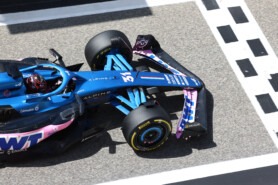Wing endplate

Esteban Ocon (FRA) Alpine F1 Team A523. Formula One Testing, Day Two, Friday 24th February 2023. Sakhir, Bahrain.
In Formula 1, wing endplates are an essential component of a car's aerodynamic package, which help generate downforce to increase grip and cornering speeds. Wing endplates are the vertical plates that are located at the outer ends of the front and rear wings, and their main function is to control the airflow around the wing.
Front wing endplates are usually shaped like a shark fin and help to channel air around the front wheels, reducing drag and turbulence. They also provide a visual reference for drivers to judge the position of their car in relation to other cars on the track.
Rear wing endplates, on the other hand, are more complex and have a significant impact on the car's performance. They are designed to create a high-pressure area underneath the wing, which generates downforce and improves traction. Rear wing endplates are often adjustable, allowing the teams to fine-tune the amount of downforce generated by the wing to suit different track conditions.
The shape and size of the wing endplates are heavily regulated by the FIA (Fédération Internationale de l'Automobile), the governing body of Formula 1, to ensure that all teams comply with the rules and maintain a level playing field. The endplates must conform to strict dimensions and must not have any additional aerodynamic devices or features that could give a team an unfair advantage.
In recent years, the design of the wing endplates has become increasingly complex, with teams using computational fluid dynamics (CFD) simulations and wind tunnel testing to refine their designs. The aim is to create a more efficient aerodynamic package that generates maximum downforce with minimal drag, thereby improving the car's overall performance.
In summary, wing endplates are a crucial part of a Formula 1 car's aerodynamic package, which helps to generate downforce and improve cornering speeds. The design of the endplates is heavily regulated by the FIA, and teams use advanced simulation and testing techniques to optimize their performance.











LAST 3 F1 Fan COMMENTS